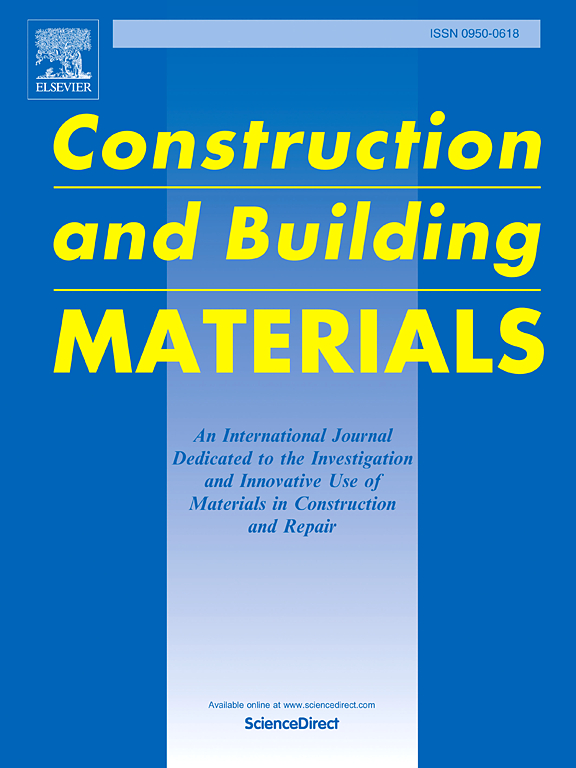基于体积法的多孔弹性沥青混合料材料组成设计研究
IF 7.4
1区 工程技术
Q1 CONSTRUCTION & BUILDING TECHNOLOGY
引用次数: 0
摘要
目前,多孔弹性路面被认为是最有效的降噪路面。然而,PERS的材料组成设计缺乏足够的理论基础和方法,尤其是骨料结构的设计和粘结剂含量的确定。本研究以多孔弹性沥青混合料(PEAM)为研究对象,采用体积理论计算相结合的室内实验方法进行材料组成设计。利用颗粒堆积理论确定了骨料粒径为2.36 ~ 4.75 mm和4.75 ~ 9.5 mm。通过充填密度试验确定骨料含量为40 %,体积含量为2.36 ~ 4.75 mm。采用改进的粗骨料空隙填充法(CAVF)计算了粘结剂和矿粉含量。路面性能试验验证了基于体积法的材料成分设计方法的合理性和可行性。PEAM的抗车辙性能与PAC-13相当。与PAC-13相比,PEAM的抗裂性能提高了30 % ~ 170 %,抗水损伤性能提高了1 % ~ 6 %,抗松动性能提高了27 % ~ 66 %。此外,PEAM的降噪性能优异,与AC-13相比,噪声降低3.1-7.7 dB(A),优于PAC-13。本研究为PERS和PEAM的材料成分设计提供了理论依据,有助于有效降低轮胎/路面噪声和废轮胎污染。本文章由计算机程序翻译,如有差异,请以英文原文为准。
Study on the material composition design of Porous Elastic Asphalt Mixture (PEAM) based on the volumetric method
Poroelastic road surfaces (PERS) are currently recognised as the most effective pavement type for noise reduction. However, the material composition design of PERS lacks a sufficient theoretical foundation and methodology, particularly for designing aggregate structures and determining the binder content. In this study, porous elastic asphalt mixture (PEAM) was used as the object, and the material composition was designed using volumetric theoretical calculations supplemented by indoor experimental methods. Aggregate particle sizes were determined to be 2.36–4.75 mm and 4.75–9.5 mm using particle packing theory. Aggregate content was established as 40 % volume content of 2.36–4.75 mm through packing density tests. The binder and mineral powder contents were calculated using a modified coarse aggregate void filling (CAVF) method. The material composition design method based on the volumetric method is reasonable and feasible, as verified by pavement performance tests. The rutting resistance of the PEAM was comparable to that of PAC-13. Compared to PAC-13, the crack resistance of PEAM improved by 30 %–170 %, the water damage resistance increased by 1 %–6 %, and the looseness resistance increased by 27 %–66 %. In addition, the noise reduction performance of PEAM is excellent, reducing noise by 3.1–7.7 dB(A) compared to AC-13, and superior to PAC-13. This study provides a theoretical foundation for the material composition design of PERS and PEAM, which can contribute to the effective reduction of tire/pavement noise and waste tire pollution.
求助全文
通过发布文献求助,成功后即可免费获取论文全文。
去求助
来源期刊

Construction and Building Materials
工程技术-材料科学:综合
CiteScore
13.80
自引率
21.60%
发文量
3632
审稿时长
82 days
期刊介绍:
Construction and Building Materials offers an international platform for sharing innovative and original research and development in the realm of construction and building materials, along with their practical applications in new projects and repair practices. The journal publishes a diverse array of pioneering research and application papers, detailing laboratory investigations and, to a limited extent, numerical analyses or reports on full-scale projects. Multi-part papers are discouraged.
Additionally, Construction and Building Materials features comprehensive case studies and insightful review articles that contribute to new insights in the field. Our focus is on papers related to construction materials, excluding those on structural engineering, geotechnics, and unbound highway layers. Covered materials and technologies encompass cement, concrete reinforcement, bricks and mortars, additives, corrosion technology, ceramics, timber, steel, polymers, glass fibers, recycled materials, bamboo, rammed earth, non-conventional building materials, bituminous materials, and applications in railway materials.
 求助内容:
求助内容: 应助结果提醒方式:
应助结果提醒方式:


